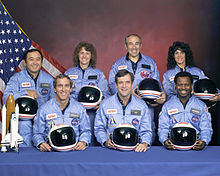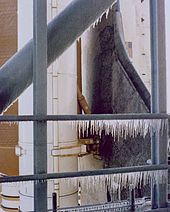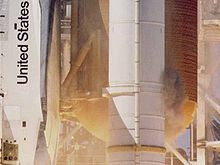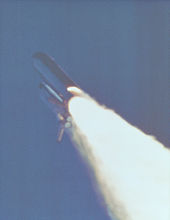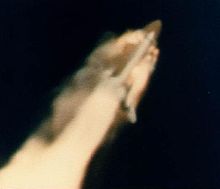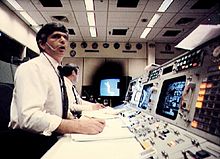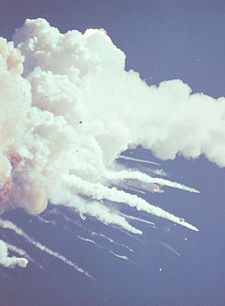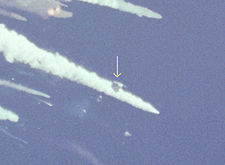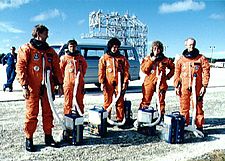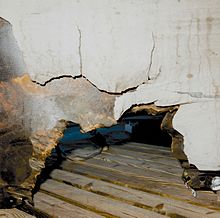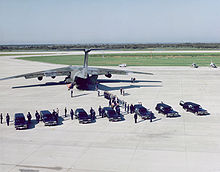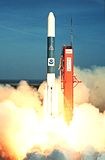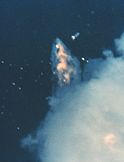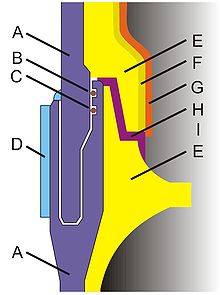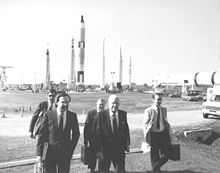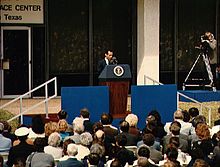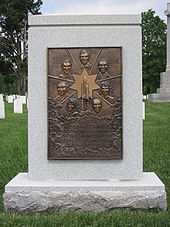
Space Shuttle Challenger disaster
Did you know...
SOS Children, which runs nearly 200 sos schools in the developing world, organised this selection. To compare sponsorship charities this is the best sponsorship link.
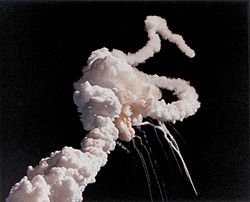 Space Shuttle Challenger's smoke plume after its in-flight breakup, resulting in its crash and the deaths of all seven crew members. |
|
| Date | January 28, 1986 |
|---|---|
| Time | 11:39:13 EST (16:39:13 UTC) |
| Location | Atlantic Ocean, off the coast of central Florida |
| Outcome | Grounding of the Space Shuttle fleet for nearly three years during which various safety measures, solid rocket booster redesign, and a new policy on management decision-making for future launches were implemented. |
| Casualties | |
| Francis R. Scobee, Commander Michael J. Smith, Pilot Ronald McNair, Mission Specialist Ellison Onizuka, Mission Specialist Judith Resnik, Mission Specialist Greg Jarvis, Payload Specialist Christa McAuliffe, Payload Specialist |
|
| Inquiries | Rogers Commission |
The Space Shuttle Challenger disaster occurred on January 28, 1986, when Space Shuttle Challenger (mission STS-51-L) broke apart 73 seconds into its flight, leading to the deaths of its seven crew members. The spacecraft disintegrated over the Atlantic Ocean, off the coast of central Florida at 11:38 EST (16:38 UTC). Disintegration of the entire vehicle began after an O-ring seal in its right solid rocket booster (SRB) failed at liftoff. The O-ring failure caused a breach in the SRB joint it sealed, allowing pressurized hot gas from within the solid rocket motor to reach the outside and impinge upon the adjacent SRB attachment hardware and external fuel tank. This led to the separation of the right-hand SRBs aft attachment and the structural failure of the external tank. Aerodynamic forces promptly broke up the orbiter.
The crew compartment and many other vehicle fragments were eventually recovered from the ocean floor after a lengthy search and recovery operation. Although the exact timing of the death of the crew is unknown, several crew members are known to have survived the initial breakup of the spacecraft. However, the shuttle had no escape system and the impact of the crew compartment with the ocean surface was too violent to be survivable.
The disaster resulted in a 32-month hiatus in the shuttle program and the formation of the Rogers Commission, a special commission appointed by United States President Ronald Reagan to investigate the accident. The Rogers Commission found NASA's organizational culture and decision-making processes had been key contributing factors to the accident. NASA managers had known contractor Morton Thiokol's design of the SRBs contained a potentially catastrophic flaw in the O-rings since 1977, but failed to address it properly. They also disregarded warnings from engineers about the dangers of launching posed by the low temperatures of that morning and had failed in adequately reporting these technical concerns to their superiors.
What Rogers did not highlight was that the vehicle was never certified to operate in temperatures that low. The O-rings, as well as many other critical components, had no test data to support any expectation of a successful launch in such conditions. Bob Ebeling from Thiokol delivered a biting analysis: "[W]e're only qualified to 40 degrees ...'what business does anyone even have thinking about 18 degrees, we're in no man's land.'"
Many viewed the launch live because of the presence of crew member Christa McAuliffe, the first member of the Teacher in Space Project and the (planned) first female teacher in space. Media coverage of the accident was extensive: one study reported that 85 percent of Americans surveyed had heard the news within an hour of the accident. The Challenger disaster has been used as a case study in many discussions of engineering safety and workplace ethics.
O-ring concerns
Each of the two Space Shuttle Solid Rocket Boosters (SRBs) that comprised part of the Space Transportation System was constructed of six sections joined in three factory joints and three "field joints". The factory joints had asbestos-silica insulation applied over the joint, while the field joints—assembled in the Vehicle Assembly Building at Kennedy Space Centre (KSC)—depended on two rubber O-rings, a primary and a secondary (backup), to seal them. (After the destruction of Challenger, SRB field joints started using three O-rings.) The seals of all of the SRB joints were required to contain the hot high-pressure gases produced by the burning solid propellant inside, forcing it out the nozzle at the aft end of each rocket.
During the Space Shuttle design process, a McDonnell Douglas report in September 1971 discussed the safety record of solid rockets. While a safe abort was possible after most types of failures, one was especially dangerous, a burnthrough by hot gases of the rocket's casing. The report stated that "if burnthrough occurs adjacent to [liquid hydrogen/oxygen] tank or orbiter, timely sensing may not be feasible and abort not possible", accurately foreshadowing the Challenger accident. Morton Thiokol was the contractor responsible for the construction and maintenance of the shuttle's SRBs. As originally designed by Thiokol, the O-ring joints in the SRBs were supposed to close more tightly due to forces generated at ignition. However, a 1977 test showed that when pressurized water was used to simulate the effects of booster combustion, the metal parts bent away from each other, opening a gap through which gases could leak. This phenomenon, known as "joint rotation," caused a momentary drop in air pressure. This made it possible for combustion gases to erode the O-rings. In the event of widespread erosion, an actual flame path could develop, causing the joint to burst—which would have destroyed the booster and the shuttle.
Engineers at the Marshall Space Flight Centre wrote to the manager of the Solid Rocket Booster project, George Hardy, on several occasions suggesting that Thiokol's field joint design was unacceptable. For example, one engineer suggested that joint rotation would render the secondary O-ring useless. However, Hardy did not forward these memos to Thiokol, and the field joints were accepted for flight in 1980.
Evidence of serious O-ring erosion was present as early as the second space shuttle mission, STS-2, which was flown by Columbia. However, contrary to NASA regulations, the Marshall Centre did not report this problem to senior management at NASA, but opted to keep the problem within their reporting channels with Thiokol. Even after the O-rings were redesignated as "Criticality 1"—meaning that their failure would result in the destruction of the Orbiter—no one at Marshall suggested that the shuttles be grounded until the flaw could be fixed.
By 1985, Marshall and Thiokol realized that they had a potentially catastrophic problem on their hands. They began the process of redesigning the joint with three inches (76 mm) of additional steel around the tang. This tang would grip the inner face of the joint and prevent it from rotating. However, they did not call for a halt to shuttle flights until the joints could be redesigned. Rather, they treated the problem as an acceptable flight risk. For example, Lawrence Mulloy, Marshall's manager for the SRB project since 1982, issued and waived launch constraints for six consecutive flights. Thiokol even went as far as to persuade NASA to declare the O-ring problem "closed". Donald Kutyna, a member of the Rogers Commission, later likened this situation to an airline permitting one of its planes to continue to fly despite evidence that one of its wings was about to fall off.
Pre-launch conditions
Delays
Challenger was originally set to launch from KSC in Florida at 14:42 Eastern Standard Time (EST) on January 22. However, delays in the previous mission, STS-61-C, caused the launch date to be moved to January 23 and then to January 24. Launch was then rescheduled to January 25 due to bad weather at the Transoceanic Abort Landing (TAL) site in Dakar, Senegal. NASA decided to use Casablanca as the TAL site, but because it was not equipped for night landings, the launch had to be moved to the morning ( Florida time). Predictions of unacceptable weather at KSC caused the launch to be rescheduled for 09:37 EST on January 27.
The launch was delayed the next day by problems with the exterior access hatch. First, one of the micro-switch indicators used to verify that the hatch was safely locked malfunctioned. Then, a stripped bolt prevented the closeout crew from removing a closing fixture from the orbiter's hatch. When the fixture was finally sawn off, crosswinds at the Shuttle Landing Facility exceeded the limits for a Return to Launch Site (RTLS) abort. The crew waited for the winds to die down until the launch window finally ran out, forcing yet another scrub.
Thiokol-NASA conference call
Forecasts for January 28 predicted an unusually cold morning, with temperatures close to 31 °F (−1 °C), the minimum temperature permitted for launch. The low temperature had prompted concern from Thiokol engineers. At a teleconference on the evening of January 27, Thiokol engineers and managers discussed the weather conditions with NASA managers from Kennedy Space Center and Marshall Space Flight Centre. Several engineers—most notably Roger Boisjoly, who had voiced similar concerns previously—expressed their concern about the effect of the temperature on the resilience of the rubber O-rings that sealed the joints of the SRBs, and recommended a launch postponement. They argued that if the O-rings were colder than 53 °F (12 °C), they did not have enough data to determine whether the joint would properly seal. This was an important consideration, since the SRB O-rings had been designated as a "Criticality 1" component, meaning that there was no backup if both the primary and secondary O-rings failed, and their failure would destroy the Orbiter and its crew.
Thiokol management initially supported its engineers' recommendation to postpone the launch, but NASA staff opposed a delay. During the conference call, Hardy told Thiokol, "I am appalled. I am appalled by your recommendation." Mulloy said, "My God, Thiokol, when do you want me to launch — next April?" One argument of NASA personnel in contest to Thiokol's concerns was that if the primary O-ring failed, the secondary O-ring would still seal. This was unproven, and was in any case an illegitimate argument for a "Criticality 1" component. As astronaut Sally Ride cited in questioning NASA managers before the Rogers Commission, it is forbidden to rely on a backup for a "Criticality 1" component. The backup is there to provide redundancy in case of unforeseen failure, not to replace the primary device, leaving no backup.
NASA did not know of Thiokol's earlier concerns about the effects of the cold on the O-rings, and did not understand that Rockwell International, the shuttle's prime contractor, viewed the large amount of ice present on the pad as a constraint to launch. Because of NASA's opposition, Thiokol management reversed itself and recommended that the launch proceed as scheduled.
Ice
The Thiokol engineers had also argued that the low overnight temperatures (18 °F or −8 °C the evening prior to launch) would almost certainly result in SRB temperatures below their redline of 40 °F (4 °C). Ice had accumulated all over the launch pad, raising concerns that ice could damage the shuttle upon lift-off. The Kennedy Ice Team inadvertently pointed an infrared camera at the aft field joint of the right SRB and found the temperature to be only 8 °F (−13 °C). This was believed to be the result of supercooled air blowing on the joint from the liquid oxygen tank vent. It was much lower than the air temperature and far below the design specifications for the O-rings. However, the 8 °F (−13 °C) reading was later determined to be erroneous, the error caused by not following the temperature probe manufacturer's instructions. Tests and adjusted calculations later confirmed that the temperature of the joint was not substantially different from the ambient temperature.
The temperature on the day of the launch was far lower than had been the case with previous launches: below freezing at 28 to 29 °F (-2.2 to -1.7 °C); previously, the coldest launch had been at 53 °F (12 °C). Although the Ice Team had worked through the night removing ice, engineers at Rockwell still expressed concern. Rockwell engineers watching the pad from their headquarters in Downey, California, were horrified when they saw the amount of ice. They feared that during launch, ice might be shaken loose and strike the shuttle's thermal protection tiles, possibly due to the aspiration induced by the jet of exhaust gas from the SRBs. Rocco Petrone, the head of Rockwell's space transportation division, and his colleagues viewed this situation as a launch constraint, and told Rockwell's managers at the Cape that Rockwell could not support a launch. However, Rockwell's managers at the Cape voiced their concerns in a manner that led Houston-based mission manager Arnold Aldrich to go ahead with the launch. Aldrich decided to postpone the shuttle launch by an hour to give the Ice Team time to perform another inspection. After that last inspection, during which the ice appeared to be melting, Challenger was finally cleared to launch at 11:38 am EST.
January 28 launch and failure
Liftoff and initial ascent
The following account of the accident is derived from real time telemetry data and photographic analysis, as well as from transcripts of air-to-ground and mission control voice communications. All times are given in seconds after launch and correspond to the telemetry time-codes from the closest instrumented event to each described event.
Until liftoff actually occurs, the Space Shuttle main engines (SSMEs) can be safely shut down and the launch aborted if necessary. At liftoff time (T=0, which was at 11:38:00.010 EST), the three SSMEs were at 100% of their original rated performance, and began throttling up to 104% under computer control. At this moment, the two SRBs were ignited and hold-down bolts were released with explosives, freeing the vehicle from the pad. With the first vertical motion of the vehicle, the gaseous hydrogen vent arm retracted from the External Tank (ET) but failed to latch back. Review of film shot by pad cameras showed that the arm did not re-contact the vehicle, and thus it was ruled out as a contributing factor in the accident. The post-launch inspection of the pad also revealed that kick springs on four of the hold-down bolts were missing, but they were similarly ruled out as a possible cause.
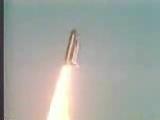
Later review of launch film showed that at T+0.678, strong puffs of dark gray smoke were emitted from the right-hand SRB near the aft strut that attaches the booster to the ET. The last smoke puff occurred at about T+2.733. The last view of smoke around the strut was at T+3.375. It was later determined that these smoke puffs were caused by the opening and closing of the aft field joint of the right-hand SRB. The booster's casing had ballooned under the stress of ignition. As a result of this ballooning, the metal parts of the casing bent away from each other, opening a gap through which hot gases—above 5,000 °F (2,760 °C)—leaked. This had occurred in previous launches, but each time the primary O-ring had shifted out of its groove and formed a seal. Although the SRB was not designed to function this way, it appeared to work well enough, and Morton-Thiokol changed the design specs to accommodate this process, known as extrusion.
While extrusion was taking place, hot gases leaked past (a process called "blow-by"), damaging the O-rings until a seal was made. Investigations by Morton-Thiokol engineers determined that the amount of damage to the O-rings was directly related to the time it took for extrusion to occur, and that cold weather, by causing the O-rings to harden, lengthened the time of extrusion. (The redesigned SRB field joint used subsequent to the Challenger accident uses an additional interlocking mortise and tang with a third O-ring, mitigating blow-by.)
On the morning of the disaster, the primary O-ring had become so hard due to the cold that it could not seal in time. The secondary O-ring was not in its seated position due to the metal bending. There was now no barrier to the gases, and both O-rings were vaporized across 70 degrees of arc. However, aluminium oxides from the burned solid propellant sealed the damaged joint, temporarily replacing the O-ring seal before actual flame rushed through the joint.
As the vehicle cleared the tower, the SSMEs were operating at 104% of their rated maximum thrust, and control switched from the Launch Control Center (LCC) at Kennedy to the Mission Control Centre (MCC) at Johnson Space Centre in Houston, Texas. To prevent aerodynamic forces from structurally overloading the orbiter, at T+28 the SSMEs began throttling down to limit the velocity of the shuttle in the dense lower atmosphere, as per normal operating procedure. At T+35.379, the SSMEs throttled back further to the planned 65%. Five seconds later, at about 5,800 metres (19,000 ft), Challenger passed through Mach 1. At T+51.860, the SSMEs began throttling back up to 104% as the vehicle passed beyond Max Q, the period of maximum aerodynamic pressure on the vehicle.
Plume
Beginning at about T+37 and for 27 seconds, the shuttle experienced a series of wind shear events that were stronger than on any previous flight.
At T+58.788, a tracking film camera captured the beginnings of a plume near the aft attach strut on the right SRB. Unknown to those on Challenger or in Houston, hot gas had begun to leak through a growing hole in one of the right-hand SRBs joints. The force of the wind shear shattered the temporary oxide seal that had taken the place of the damaged O-rings, removing the last barrier to flame rushing through the joint. Had it not been for the wind shear, the fortuitous oxide seal might have held through booster burnout.
Within a second, the plume became well defined and intense. Internal pressure in the right SRB began to drop because of the rapidly enlarging hole in the failed joint, and at T+60.238 there was visual evidence of flame burning through the joint and impinging on the external tank.
At T+64.660, the plume suddenly changed shape, indicating that a leak had begun in the liquid hydrogen tank, located in the aft portion of the external tank. The nozzles of the main engines pivoted under computer control to compensate for the unbalanced thrust produced by the booster burn-through. The pressure in the shuttle's external liquid hydrogen tank began to drop at T+66.764, indicating the effect of the leak.
At this stage the situation still seemed normal both to the astronauts and to flight controllers. At T+68, the CAPCOM Richard O. Covey informed the crew that they were "go at throttle up", and Commander Dick Scobee confirmed the call. His response, "Roger, go at throttle up," was the last communication from Challenger on the air-to-ground loop.
Vehicle breakup
At T+72.284, the right SRB apparently pulled away from the aft strut attaching it to the external tank. Later analysis of telemetry data showed a sudden lateral acceleration to the right at T+72.525, which may have been felt by the crew. The last statement captured by the crew cabin recorder came just half a second after this acceleration, when Pilot Michael J. Smith said "Uh oh." Smith may also have been responding to onboard indications of main engine performance, or to falling pressures in the external fuel tank.
At T+73.124, the aft dome of the liquid hydrogen tank failed, producing a propulsive force that pushed the hydrogen tank into the liquid oxygen tank in the forward part of the ET. At the same time, the right SRB rotated about the forward attach strut, and struck the intertank structure. This resulted in the spontaneous conflagration of the fuel which exploded the external tank, creating a massive plume of water vapor exhaust that enveloped the entire stack.
The breakup of the vehicle began at T+73.162 seconds and at an altitude of 48,000 feet (15 km). With the external tank disintegrating (and with the semi-detached right SRB contributing its thrust on an anomalous vector), Challenger veered from its correct attitude with respect to the local air flow and was quickly torn apart by abnormal aerodynamic forces (the orbiter itself did not explode), resulting in a load factor of up to 20 (or 20 g), well over its design limit of 5 g. The two SRBs, which can withstand greater aerodynamic loads, separated from the ET and continued in uncontrolled powered flight for another 37 seconds. The SRB casings were made of half-inch (12.7 mm) thick steel and were much stronger than the orbiter and ET; thus, both SRBs survived the breakup of the space shuttle stack, even though the right SRB was still suffering the effects of the joint burn-through that had set the destruction of Challenger in motion.
The more robustly constructed crew cabin and SRBs survived the breakup of the launch vehicle; while the SRBs were subsequently detonated remotely by the Range Safety Officer, the detached cabin continued along a ballistic trajectory, and was observed exiting the cloud of gases at T+75.237. Twenty-five seconds after the breakup of the vehicle, the trajectory of the crew compartment peaked at a height of 65,000 feet (20 km).
The Thiokol engineers who had opposed the decision to launch watched the events on television. They believed that any O-ring failure would have occurred at liftoff, so were happy to see the shuttle successfully leave the launch pad. At about one minute after liftoff, a friend of Boisjoly said to him "Oh God. We made it. We made it!" Boisjoly recalled that when the shuttle exploded a few seconds later, "we all knew exactly what happened."
Post-breakup flight controller dialog
In Mission Control, there was a burst of static on the air-to-ground loop as Challenger disintegrated. Television screens showed a cloud of smoke and water vapor (the product of hydrogen combustion) where Challenger had been, with pieces of debris falling toward the ocean. At about T+89, flight director Jay Greene prompted his flight dynamics officer (FIDO) for information. FIDO responded that "...the (radar) filter has discreting sources", a further indication that Challenger had broken into multiple pieces. A minute later, the ground controller reported "negative contact (and) loss of downlink" of radio and telemetry data from Challenger. Greene ordered his team to "watch your data carefully" and look for any sign that the Orbiter had escaped.
At T+110.250, the Range Safety Officer (RSO) at the Cape Canaveral Air Force Station sent radio signals that activated the range safety system's "destruct" packages on board both solid rocket boosters. This was a normal contingency procedure, undertaken because the RSO judged the free-flying SRBs a possible threat to land or sea. The same destruct signal would have destroyed the External Tank had it not already disintegrated.
"Flight controllers here looking very carefully at the situation," reported public affairs officer Steve Nesbitt. "Obviously a major malfunction. We have no downlink." After a pause, Nesbitt said, "We have a report from the Flight Dynamics Officer that the vehicle has exploded."
Greene ordered that contingency procedures be put into effect at Mission Control; these procedures included locking the doors of the control centre, shutting down telephone communications with the outside world, and following checklists that ensured that the relevant data were correctly recorded and preserved.
Cause and time of death
The crew cabin, made of reinforced aluminium, was a particularly robust section of the shuttle. During vehicle breakup, it detached in one piece and slowly tumbled into a ballistic arc. NASA estimated the load factor at separation to be between 12 and 20 g; however, within two seconds it had already dropped to below 4 g and within ten seconds the cabin was in free fall. The forces involved at this stage were likely insufficient to cause major injury.
At least some of the astronauts were likely alive and briefly conscious after the breakup, as three of the four recovered Personal Egress Air Packs (PEAPs) on the flight deck were found to have been activated. Investigators found their remaining unused air supply roughly consistent with the expected consumption during the 2 minute 45 second post-breakup trajectory.
While analyzing the wreckage, investigators discovered that several electrical system switches on Pilot Mike Smith's right-hand panel had been moved from their usual launch positions. Fellow Astronaut Richard Mullane wrote, "These switches were protected with lever locks that required them to be pulled outward against a spring force before they could be moved to a new position." Later tests established that neither force of the explosion nor the impact with the ocean could have moved them, indicating that Smith made the switch changes, presumably in a futile attempt to restore electrical power to the cockpit after the crew cabin detached from the rest of the orbiter.
Whether the astronauts remained conscious long after the breakup is unknown, and largely depends on whether the detached crew cabin maintained pressure integrity. If it did not, the time of useful consciousness at that altitude is just a few seconds; the PEAPs supplied only unpressurized air, and hence would not have helped the crew to retain consciousness. The cabin hit the ocean surface at roughly 207 mph (333 km/h), with an estimated deceleration at impact of well over 200 g, far beyond the structural limits of the crew compartment or crew survivability levels.
On July 28, 1986, Rear Admiral Richard H. Truly, NASA's Associate Administrator for Space Flight and a former astronaut, released a report from Joseph P. Kerwin, biomedical specialist from the Johnson Space Centre in Houston, relating to the deaths of the astronauts in the accident. Kerwin, a veteran of the Skylab 2 mission, had been commissioned to undertake the study soon after the accident. According to the Kerwin Report:
The findings are inconclusive. The impact of the crew compartment with the ocean surface was so violent that evidence of damage occurring in the seconds which followed the disintegration was masked. Our final conclusions are:
- the cause of death of the Challenger astronauts cannot be positively determined;
- the forces to which the crew were exposed during Orbiter breakup were probably not sufficient to cause death or serious injury; and
- the crew possibly, but not certainly, lost consciousness in the seconds following Orbiter breakup due to in-flight loss of crew module pressure.
Some experts believed most if not all of the crew were alive and possibly conscious during the entire descent until impact with the ocean. Astronaut and NASA lead accident investigator Robert Overmyer said "Scob fought for any and every edge to survive. He flew that ship without wings all the way down....they were alive."
Crew escape was not possible
During powered flight of the space shuttle, crew escape was not possible. While launch escape systems were considered several times during shuttle development, NASA's conclusion was that the shuttle's expected high reliability would preclude the need for one. Modified SR-71 Blackbird ejection seats and full pressure suits were used on the first four shuttle orbital missions, which were considered test flights, but they were removed for the "operational" missions that followed. (The Columbia Accident Investigation Board later declared, after the 2003 Columbia re-entry disaster, that the space shuttle system should never have been declared operational because it is experimental by nature due to the limited number of flights as compared to certified commercial aircraft.) Providing a launch escape system for larger crews was considered undesirable due to "limited utility, technical complexity and excessive cost in dollars, weight or schedule delays."
After the loss of Challenger, the question was re-opened, and NASA considered several different options, including ejector seats, tractor rockets and bailing out through the bottom of the orbiter. However, NASA once again concluded that all of the launch escape systems considered would be impractical due to the sweeping vehicle modifications that would have been necessary and the resultant limitations on crew size. A system was designed to give the crew the option to leave the shuttle during gliding flight; however, this system would not have been usable in the Challenger situation.
Aftermath
Tributes
On the night of the disaster, President Ronald Reagan had been scheduled to give his annual State of the Union address. He initially announced that the address would go on as scheduled, but then postponed the State of the Union address for a week and instead gave a national address on the Challenger disaster from the Oval Office of the White House. It was written by Peggy Noonan, and is considered one of the greatest speeches of the 20th century. It finished with the following statement, which quoted from the poem "High Flight" by John Gillespie Magee, Jr.:
We will never forget them, nor the last time we saw them, this morning, as they prepared for their journey and waved goodbye and 'slipped the surly bonds of Earth' to 'touch the face of God.'
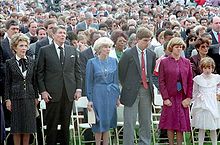
Three days later, Reagan and his wife Nancy traveled to the Johnson Space Centre to speak at a memorial service honoring the astronauts where he stated:
Sometimes, when we reach for the stars, we fall short. But we must pick ourselves up again and press on despite the pain.
It was attended by 6,000 NASA employees and 4,000 guests, as well as by the families of the crew. During the ceremony, an Air Force band led the singing of " God Bless America" as NASA T-38 Talon jets flew directly over the scene, in the traditional missing-man formation. All activities were broadcast live by the national television networks.
President Reagan would further mention the Challenger astronauts at the beginning of his State of the Union address on February 4.
Recovery of debris
In the first minutes after the accident, recovery efforts were begun by NASA's Launch Recovery Director, who ordered the ships used by NASA for recovery of the solid rocket boosters to be sent to the location of the water impact. Search and rescue aircraft were also dispatched. At this stage, however, debris was still falling, and the Range Safety Officer (RSO) held both aircraft and ships out of the impact area until it was considered safe for them to enter. It was about an hour until the RSO allowed the recovery forces to begin their work.
The search and rescue operations that took place in the first week after the Challenger accident were managed by the Department of Defense on behalf of NASA, with assistance from the United States Coast Guard, and mostly involved surface searches. According to the Coast Guard, "the operation was the largest surface search in which they had participated." This phase of operations lasted until February 7. Thereafter, recovery efforts were managed by a Search, Recovery, and Reconstruction team; its aim was to salvage debris that would help in determining the cause of the accident. Sonar, divers, remotely operated submersibles and manned submersibles were all used during the search, which covered an area of 480 nautical miles (890 km), and took place at depths of up to 370 metres (1,210 ft). On March 7, divers from the USS Preserver identified what might be the crew compartment on the ocean floor. The finding, along with discovery of the remains of all seven crew members, was confirmed the next day and on March 9, NASA announced the finding to the press.
By May 1, enough of the right solid rocket booster had been recovered to determine the original cause of the accident, and the major salvage operations were concluded. While some shallow-water recovery efforts continued, this was unconnected with the accident investigation; it aimed to recover debris for use in NASA's studies of the properties of materials used in spacecraft and launch vehicles. The recovery operation was able to pull 15 short tons (14 t) of debris from the ocean; 55% of Challenger, 5% of the crew cabin and 65% of the satellite cargo is still missing. Some of the missing debris continued to wash up on Florida shores for some years, such as on December 17, 1996, nearly 11 years after the incident, when two large pieces of the shuttle were found at Cocoa Beach. Under 18 U.S.C. § 641 it is against the law to be in possession of Challenger debris, and any newly discovered pieces must be turned in to NASA.
On board Challenger was an American flag, dubbed the Challenger flag, that was sponsored by Boy Scout Troop 514 of Monument, Colorado. It was recovered intact, still sealed in its plastic container.
All recovered non-organic debris from Challenger was ultimately interred in a former missile silo at Cape Canaveral Air Force Station Launch Complex 31.
Funeral ceremonies
The remains of the crew that were identifiable were returned to their families on April 29, 1986. Three of the crew members, Judith Resnik, Dick Scobee and posthumously promoted Capt. Michael J. Smith, were buried by their families at Arlington National Cemetery at individual grave sites. Mission Specialist Lt Col Ellison Onizuka was buried at the National Memorial Cemetery of the Pacific in Honolulu, Hawaii. Unidentified crew remains were buried communally at the Space Shuttle Challenger Memorial in Arlington on May 20, 1986.
NASA crisis
Several National Reconnaissance Office (NRO) satellites that only the shuttle could launch were grounded because of the accident, a dilemma NRO had feared since the 1970s when the shuttle was designated as the United States' primary launch system for all government and commercial payloads. NASA had difficulties with its own Titan rocket and Delta rocket programs, due to other unexpected rocket failures occurring before and after the Challenger disaster. On August 28, 1985, a Titan 34D carrying a KH-11 KENNAN satellite exploded after liftoff over Vandenberg Air Force Base, when the first stage propellant motor failed. It was the first failure of a Titan missile since 1978. On April 18, 1986, another Titan 34D-9 carrying a classified payload, said to be a Big Bird spy satellite, exploded at about 830 feet above the pad after liftoff over Vandenberg AFB, when a burnthrough occurred on one of the rocket boosters. On May 3, 1986, a Delta 3914 carrying the GOES-G weather satellite exploded 71 seconds after liftoff over Cape Canaveral Air Force Station due to an electrical malfunction on the Delta's first stage, which prompted the range safety officer on the ground to decide to destroy the rocket, just as a few of the rocket's boosters were jettisoned. As a result of these three failures, NASA decided to cancel all Titan and Delta launches from Cape Canaveral and Vandenberg for four months, until the problem in the rockets' designs were solved.
Investigation
In the aftermath of the accident, NASA was criticized for its lack of openness with the press. The New York Times noted on the day after the accident that "neither Jay Greene, flight director for the ascent, nor any other person in the control room, was made available to the press by the space agency". In the absence of reliable sources, the press turned to speculation; both The New York Times and United Press International ran stories suggesting that a fault with the space shuttle external tank had caused the accident, despite the fact that NASA's internal investigation had quickly focused in on the solid rocket boosters. "The space agency," wrote space reporter William Harwood, "stuck to its policy of strict secrecy about the details of the investigation, an uncharacteristic stance for an agency that long prided itself on openness."
Rogers Commission
The Presidential Commission on the Space Shuttle Challenger Accident, also known as the Rogers Commission (after its chairman), was formed to investigate the disaster. The commission members were Chairman William P. Rogers, Vice Chairman Neil Armstrong, David Acheson, Eugene Covert, Richard Feynman, Robert Hotz, Donald Kutyna, Sally Ride, Robert Rummel, Joseph Sutter, Arthur Walker, Albert Wheelon, and Chuck Yeager. The commission worked for several months and published a report of its findings. It found that the Challenger accident was caused by a failure in the O-rings sealing a joint on the right solid rocket booster, which allowed pressurized hot gases and eventually flame to "blow by" the O-ring and make contact with the adjacent external tank, causing structural failure. The failure of the O-rings was attributed to a faulty design, whose performance could be too easily compromised by factors including the low temperature on the day of launch.
More broadly, the report also considered the contributing causes of the accident. Most salient was the failure of both NASA and Morton Thiokol to respond adequately to the danger posed by the deficient joint design. Rather than redesigning the joint, they came to define the problem as an acceptable flight risk. The report found that managers at Marshall had known about the flawed design since 1977, but never discussed the problem outside their reporting channels with Thiokol—a flagrant violation of NASA regulations. Even when it became more apparent how serious the flaw was, no one at Marshall considered grounding the shuttles until a fix could be implemented. On the contrary, Marshall managers went as far as to issue and waive six launch constraints related to the O-rings. The report also strongly criticized the decision-making process that led to the launch of Challenger, saying that it was seriously flawed.
...failures in communication... resulted in a decision to launch 51-L based on incomplete and sometimes misleading information, a conflict between engineering data and management judgments, and a NASA management structure that permitted internal flight safety problems to bypass key Shuttle managers.
One of the commission's best-known members was theoretical physicist Richard Feynman. During a televised hearing, he famously demonstrated how the O-rings became less resilient and subject to seal failures at ice-cold temperatures by immersing a sample of the material in a glass of ice water. He was so critical of flaws in NASA's "safety culture" that he threatened to remove his name from the report unless it included his personal observations on the reliability of the shuttle, which appeared as Appendix F. In the appendix, he argued that the estimates of reliability offered by NASA management were wildly unrealistic, differing as much as a thousandfold from the estimates of working engineers. "For a successful technology," he concluded, "reality must take precedence over public relations, for nature cannot be fooled."
U.S. House Committee hearings
The U.S. House Committee on Science and Technology also conducted hearings, and on October 29, 1986, released its own report on the Challenger accident. The committee reviewed the findings of the Rogers Commission as part of its investigation, and agreed with the Rogers Commission as to the technical causes of the accident. However, it differed from the committee in its assessment of the accident's contributing causes:
...the Committee feels that the underlying problem which led to the Challenger accident was not poor communication or underlying procedures as implied by the Rogers Commission conclusion. Rather, the fundamental problem was poor technical decision-making over a period of several years by top NASA and contractor personnel, who failed to act decisively to solve the increasingly serious anomalies in the Solid Rocket Booster joints.
NASA response
After the Challenger accident, further shuttle flights were suspended, pending the results of the Rogers Commission investigation. Whereas NASA had held an internal inquiry into the Apollo 1 fire in 1967, its actions after Challenger were more constrained by the judgment of outside bodies. The Rogers Commission offered nine recommendations on improving safety in the space shuttle program, and NASA was directed by President Reagan to report back within thirty days as to how it planned to implement those recommendations.
In response to the commission's recommendation, NASA initiated a total redesign of the space shuttle's solid rocket boosters, which was watched over by an independent oversight group as stipulated by the commission. NASA's contract with Morton Thiokol, the contractor responsible for the solid rocket boosters, included a clause stating that in the event of a failure leading to "loss of life or mission," Thiokol would forfeit $10 million of its incentive fee and formally accept legal liability for the failure. After the Challenger accident, Thiokol agreed to "voluntarily accept" the monetary penalty in exchange for not being forced to accept liability.
NASA also created a new Office of Safety, Reliability and Quality Assurance, headed as the commission had specified by a NASA associate administrator who reported directly to the NASA administrator. George Martin, formerly of Martin Marietta, was appointed to this position. Former Challenger flight director Jay Greene became chief of the Safety Division of the directorate.
The unrealistically optimistic launch schedule pursued by NASA had been criticized by the Rogers Commission as a possible contributing cause to the accident. After the accident, NASA attempted to aim at a more realistic shuttle flight rate: it added another orbiter, Endeavour, to the space shuttle fleet to replace Challenger, and it worked with the Department of Defense to put more satellites in orbit using expendable launch vehicles rather than the shuttle. In August 1986, President Reagan also announced that the shuttle would no longer carry commercial satellite payloads. After a 32-month hiatus, the next shuttle mission, STS-26, was launched on September 29, 1988.
Although changes were made by NASA after the Challenger accident, many commentators have argued that the changes in its management structure and organizational culture were neither deep nor long-lasting.
After the Space Shuttle Columbia disaster in 2003, attention once again focused on the attitude of NASA management towards safety issues. The Columbia Accident Investigation Board (CAIB) concluded that NASA had failed to learn many of the lessons of Challenger. In particular, the agency had not set up a truly independent office for safety oversight; the CAIB felt that in this area, "NASA's response to the Rogers Commission did not meet the Commission's intent". The CAIB believed that "the causes of the institutional failure responsible for Challenger have not been fixed," saying that the same "flawed decision making process" that had resulted in the Challenger accident was responsible for Columbia's destruction seventeen years later.
Use as case study
The Challenger accident has frequently been used as a case study in the study of subjects such as engineering safety, the ethics of whistle-blowing, communications, group decision-making, and the dangers of groupthink. It is part of the required readings for engineers seeking a professional license in Canada and other countries. Roger Boisjoly, the engineer who had warned about the effect of cold weather on the O-rings, left his job at Morton Thiokol and became a speaker on workplace ethics. He argues that the caucus called by Morton Thiokol managers, which resulted in a recommendation to launch, "constituted the unethical decision-making forum resulting from intense customer intimidation." For his honesty and integrity leading up to and directly following the shuttle disaster, Roger Boisjoly was awarded the Prize for Scientific Freedom and Responsibility from the American Association for the Advancement of Science. Many colleges and universities have also used the accident in classes on the ethics of engineering.
Information designer Edward Tufte has claimed that the Challenger accident is an example of the problems that can occur from the lack of clarity in the presentation of information. He argues that if Morton Thiokol engineers had more clearly presented the data that they had on the relationship between low temperatures and burn-through in the solid rocket booster joints, they might have succeeded in persuading NASA managers to cancel the launch; to demonstrate, he took all of the data he claimed Thiokol had given during the briefing and placed it on a single graph of O-ring damage versus external launch temperature, showing an alleged effects of cold on the degree of O-Ring damage, then placed the proposed launch of Challenger on the graph according to its predicted temperature at launch. According to Tufte the launch of Challenger was so far away from the coldest launch with the worst damage ever seen to date that even a casual observer could have determined the danger level was severe. Tufte has also argued that poor presentation of information may have affected NASA decisions during the last flight of Columbia. Robison, a Rochester Institute of Technology professor, and Boisjoly vigorously refuted Tufte's conclusions about the Morton Thiokol engineers' role in the loss of Challenger. First they say that the engineers didn't have the information available as Tufte claimed: "But they did not know the temperatures even though they did try to obtain that information. Tufte has not gotten the facts right even though the information was available to him had he looked for it." They further argue that Tufte "misunderstands thoroughly the argument and evidence the engineers gave". They also criticised Tufte's diagram as "fatally flawed by Tufte's own criteria. The vertical axis tracks the wrong effect, and the horizontal axis cites temperatures not available to the engineers and, in addition, mixes O-ring temperatures and ambient air temperature as though the two were the same."
Continuation of the Shuttle Program
After the accident, NASA's Space Shuttle fleet was grounded for almost three years while the investigation, hearings, engineering redesign of the SRBs, and other behind-the-scenes technical and management reviews, changes, and preparations were taking place. At 11:37 on September 29, 1988, Space Shuttle Discovery lifted off with a crew of five from Kennedy Space Centre pad 39-B. It carried a Tracking and Data Relay Satellite, TDRS-C (named TDRS-3 after deployment), which replaced TDRS-B, the satellite that was launched and lost on Challenger. The "Return to Flight" launch of Discovery also represented a test of the redesigned boosters, a shift to a more conservative stance on safety (e.g., it was the first time the crew had launched in pressure suits since STS-4, the last of the four initial Shuttle test flights), and a chance to restore national pride in the American space program, especially manned space flight. The mission, STS-26, was a success (with only two minor system failures, one of a cabin cooling system and one of a Ku-band antenna), and a regular schedule of STS flights followed, continuing without extended interruption until the 2003 Columbia disaster.
Barbara Morgan, the backup astronaut for McAuliffe who trained with her in the Teacher in Space program and was at KSC watching her launch on January 28, 1986, flew on STS-118 as a Mission Specialist in August 2007.
Legacy
The families of the Challenger crew organized the Challenger Centre for Space Science Education as a permanent memorial to the crew. Fifty-two learning centers have been established by this non-profit organization.
An elementary school in Nogales, Arizona, commemorates the accident in name, Challenger Elementary School, and their school motto, "Reach for the sky". The suburbs of Seattle, Washington are home to Challenger Elementary School in Issaquah, Washington and Christa McAuliffe Elementary School in Sammamish, Washington. In San Diego, California, the next-opened public middle school in the San Diego Unified School District was named Challenger Middle School. The City of Palmdale, the birthplace of the entire shuttle fleet, and its neighbour City of Lancaster, California, both renamed 10th Street East, from Avenue M to Edwards Air Force Base, to Challenger Way in honour of the lost shuttle and its crew. This was the road that the Challenger, Enterprise, and Columbia all were towed along in their initial move from U.S. Air Force Plant 42 to Edwards AFB after completion since Palmdale airport had not yet installed the shuttle crane for placement of an orbiter on the 747 Shuttle Carrier Aircraft. In addition, the City of Lancaster has built Challenger Middle School, and Challenger Memorial Hall at the former site of the Antelope Valley Fairgrounds, all in tribute to the Challenger shuttle and crew. The public Peers Park in Palo Alto, California features a "Challenger Memorial Grove" that includes redwood trees grown from seeds carried aboard Challenger in 1985.
In Cocoa, Brevard County, Florida (the county where Cape Canaveral and KSC are located), Challenger 7 Elementary School is named in memory of the seven astronauts who lost their lives. There is also a middle school in neighboring Rockledge, McNair Magnet School, named after astronaut Ronald McNair. A middle school in Boynton Beach, Florida, is named after deceased teacher/astronaut, Christa McAuliffe. There are also schools in Lowell, Massachusetts, and Lenexa, Kansas, named in honour of Christa McAuliffe. The McAuliffe-Shepard Discovery Centre, a science museum and planetarium in Concord, New Hampshire, is also partly named in her honour. There is also an elementary school in Germantown, Maryland, named after Christa McAuliffe as well as in Green Bay, Wisconsin. The draw bridge over the barge canal on State Rd.3 on Merritt Island, Florida, is named the Christa McAuliffe Memorial Bridge.
In 2004, President George W. Bush conferred posthumous Congressional Space Medals of Honour to all 14 astronauts lost in the Challenger and Columbia accidents.
British heavy metal band TANK has a song in their 1987 album Tank named It fell from the Sky dedicated to the Challenger disaster.
In Owl City's 2011 album, All Things Bright and Beautiful (album), the song "January 28th, 1986" was written in commemoration of the Challenger incident and the deaths of the astronauts aboard it. Lyrics include snippets from Ronald Reagan's tragedy address.
Video documentation
The disaster is notable for the lack of video documentation of the event. Until 2010, the live broadcast of the launch and subsequent disaster by CNN was the only known on-location video footage from within range of the launch site. In 2012, four other motion picture recordings of the event were publicly released:
- a video recording by Jack Moss from the front yard of his house in Winter Haven, Florida, 80 miles (130 km) from Cape Canaveral
- a video recording by Bob Karman from Orlando International Airport, 50 miles (80 km) from Cape Canaveral
- a Super 8 mm film recorded by then-19-year-old Jeffrey Ault of Orange City, Florida, at the Kennedy Space Centre, some 10 miles (16 km) from the launch
- a video recording by Steven Virostek uncovered in May 2012
Film
A BBC docudrama titled The Challenger was broadcast on March 18, 2013, based on the last of Richard Feynman's autobiographical works, What Do You Care What Other People Think?. It stars William Hurt as Richard Feynman. It includes the notion that NASA promised the US Air Force that it could launch military payloads on the Shuttle, in order to get funding that would have been earmarked for development of the Titan IV expendable launcher. Numerous delays on previous flights had already reduced NASA's credibility, and after the Challenger disaster, the Air Force was able to develop the Titan IV instead of the Shuttle.
